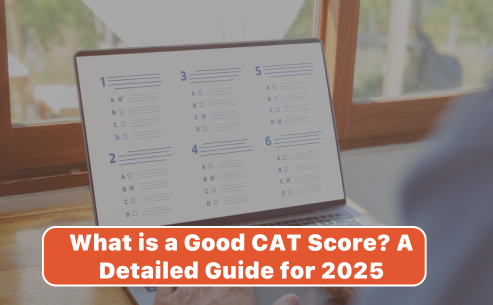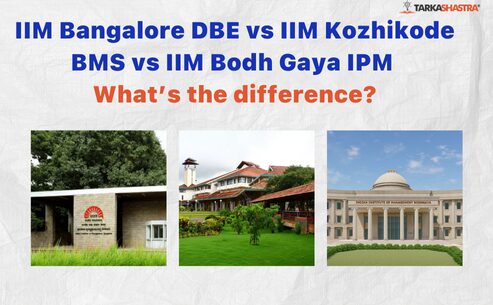The IPMAT Indore (Integrated Programme in Management Aptitude Test) is not just another entrance exam—it’s the gateway to one of India’s most prestigious management programs offered by IIM Indore. Every year, thousands of aspirants compete for a few hundred seats, making it one of the most competitive UG-level management exams. The Quantitative Aptitude (QA) is the most challenging yet rewarding of its three sections.
What makes IPMAT Indore unique is the dual structure of Quantitative Aptitude:
- MCQs (Multiple-Choice Questions): Test your speed, accuracy, and problem-solving under pressure.
- Short-Answer (SA) Questions: No options are provided, requiring more profound conceptual clarity, precise calculations, and error-free execution.
Unlike other BBA entrance exams (like NPAT, SET, or CUET), which stick to Class 10-level math, IPMAT Indore raises the bar with Class 11–12 topics such as sequences, functions, and logarithms. This is why Quant often becomes the “make-or-break” section for aspirants.
Why Focus on Quantitative Aptitude?
| Factor | Why It Matters in IPMAT Indore |
| Weightage | Nearly 50% of the exam comes from Quantitative Aptitude (MCQ + SA). |
| Difficulty | Includes Class 11–12 concepts unlike other BBA exams, making it more competitive. |
| Cut-off Impact | Failing to clear Quant cut-off = disqualification, even with high Verbal score. |
| SA Advantage | No negative marking in the Short-Answer section = golden chance to maximize score. |
In this blog, we’ll dive deep into preparing for Quant MCQs and Short-Answer questions, with strategies, topic-wise analysis, weightage tables, and a structured roadmap designed for IPMAT Indore aspirants.
Understanding the Quantitative Aptitude Structure (IPMAT Indore)
Before jumping into preparation strategies, it’s essential to understand the structure of the Quantitative Aptitude section in IPMAT Indore. Unlike most undergraduate management entrance exams, IPMAT Indore has a dual-format Quant section that tests both speed and depth of mathematical knowledge.
Key Features of Quantitative Aptitude in IPMAT Indore
- Two-part Structure: Divided into MCQs (Multiple-Choice Questions) and SA (Short-Answer Questions).
- Sectional Time Limit: Each section gets 40 minutes; no time carryover.
- Marking Scheme: +4 for correct answers, -1 for wrong MCQs, and no negative for SA.
- Conceptual vs Speed Balance: MCQs test efficiency; SA demands accuracy and clarity.
- Cut-off System: Candidates must clear sectional cut-offs in both QA-MCQ and QA-SA.
Exam Pattern for Quantitative Aptitude (IPMAT Indore 2026)
| Section | No. of Questions | Time Limit | Marking Scheme | Key Challenge |
| Quantitative Aptitude (MCQ) | 30 | 40 mins | +4 for correct, -1 for incorrect | Balancing speed with accuracy |
| Quantitative Aptitude (Short-Answer – SA) | 15 | 40 mins | +4 for correct, 0 for incorrect | Solving without options, conceptual depth |
Why This Matters
- MCQs: Ideal for testing quick problem-solving skills in Arithmetic, Algebra, and DI.
- SA Questions: Designed to eliminate guesswork—only genuine conceptual clarity and precise calculations can help you score.
- Strategic Importance: Since SA carries no penalty, attempting all 15 is recommended. Even partial knowledge can fetch marks.
Bottom line: Success in IPMAT Indore Quant is about mastering both formats simultaneously—speed for MCQs and depth for SA.
Syllabus Focus for Quantitative Aptitude (IPMAT Indore)
The Quantitative Aptitude section in IPMAT Indore checks whether aspirants have both breadth and depth in mathematics. While the MCQ section tests speed and accuracy across various topics, the Short-Answer section pushes students to apply higher-order concepts with precision.
A. Quantitative Aptitude (MCQ) — Speed + Accuracy
The 30 MCQs in this section cover a broad mix of Arithmetic, Algebra, Geometry, and Data Interpretation. The questions are often moderate in difficulty but time-pressured.
Key Topics for MCQ Section
| Area | Subtopics / Concepts | Approx. No. of Questions | Difficulty |
| Arithmetic | Percentages, Profit & Loss, Ratios & Proportion, Mixtures, Averages, SI & CI, Time-Speed-Distance, Time & Work | 10–12 | Easy to Moderate |
| Algebra | Linear & Quadratic Equations, Functions, Inequalities | 5–6 | Moderate |
| Geometry & Mensuration | Triangles, Circles, Polygons, Surface Area & Volume | 2–3 | Moderate |
| Data Interpretation | Tables, Bar Graphs, Pie Charts, Line Graphs (one full set) | 5 | Moderate |
| Miscellaneous | Set Theory, Permutation–Combination, Probability, Sequences & Series, Logarithms | 4–5 | Moderate to Difficult |
Key Insights:
- Arithmetic dominates with ~40% weightage.
- A full DI set (5 Qs) almost always appears.
- Algebra is steady and unavoidable, especially quadratic equations & functions.
B. Quantitative Aptitude (Short-Answer – SA) — Conceptual Depth
The 15 SA questions test higher-level mathematics. With no answer choices provided, aspirants must calculate the exact solution. This section leans heavily on Algebra, Number System, Functions, and Sequences, making it tougher than MCQs.
Key Topics for the SA Section
| Area | Subtopics / Concepts | Approx. No. of Questions | Difficulty |
| Algebra (Advanced) | Quadratic & Cubic Equations, Factorization, Identities | 3–4 | Moderate to Difficult |
| Sequences & Series | AP, GP, HP, Special Series (squares, cubes, sum of terms) | 2–3 | Moderate to Difficult |
| Functions & Graphs | Domain, Range, Composite Functions, Piecewise Functions | 2 | Difficult |
| Number System | HCF, LCM, Cyclicity, Highest Power, Remainders | 2 | Moderate |
| Logarithms & Surds | Laws of Logs, Simplification, Exponents | 1–2 | Moderate |
| Geometry & Coordinate Geometry | Triangles, Circles, Lines, Slopes | 1–2 | Moderate |
| Others (Miscellaneous) | Inequalities, Trigonometry (basic), Logical Math Puzzles | 1–2 | Moderate to Difficult |
Key Insights:
- The SA section is algebra-heavy, and mastering functions, logs, and sequences is critical.
- No negative marking = attempt all 15 questions, even if unsure.
- Conceptual clarity matters more than shortcuts here.
Together, the MCQ + SA sections test nearly all core areas of Class 9–12 mathematics. Still, the focus remains on Arithmetic, Algebra, DI, and advanced Algebra.
Weightage & Difficulty Trends (Past Papers)
One of the most innovative ways to prepare for IPMAT Indore is to analyse trends in previous years’ papers. Over the years, a consistent pattern has emerged: Arithmetic, Algebra, and Data Interpretation (DI) account for 70–80% of the Quantitative Aptitude section.
A. Why Trends Matter
- Helps prioritise high-return topics (Arithmetic, Algebra, DI).
- Gives clarity on MCQ vs SA weightage.
- It shows how Indore differs from other exams (with higher Algebra emphasis).
- Prevents wasting time on low-frequency topics like advanced Geometry or Probability.
B. Topic-Wise Distribution in IPMAT Indore (MCQ + SA)
| Year | Arithmetic | Algebra | Data Interpretation | Other Topics (Geometry, Probability, etc.) |
| 2023 | 38% | 32% | 15% | 15% |
| 2024 | 40% | 30% | 15% | 15% |
| 2025 | 37% | 31% | 17% | 15% |
Observation:
- Arithmetic dominates MCQs (Profit–Loss, Ratios, TSD, Work).
- Algebra dominates SA (Functions, Sequences, Logs).
- DI is consistently 15–17% (usually one complete set).
C. Difficulty Level Overview
| Section | Level of Difficulty | Key Challenge |
| Quant MCQ | Moderate to Difficult | Speed + accuracy under strict 40-min limit |
| Quant SA | Difficult | Requires conceptual clarity; no options to fall back on |
Key Insights:
- Indore’s SA section is considered more challenging than any other BBA entrance exam because it pushes students beyond shortcuts.
- MCQs balance out the paper with moderate questions, but time pressure makes them tricky.
In short, if you master Arithmetic (speed), Algebra (depth), and DI (accuracy), you’re already prepared to tackle 70–80% of the Quant paper.
Preparation Strategy for Quant MCQs
The 30 MCQs in IPMAT Indore Quantitative Aptitude are designed to test your speed, accuracy, and ability to apply concepts quickly. Since every wrong answer carries a -1 penalty, the brilliant selection of questions becomes as important as solving them correctly.
A. Step-by-Step Preparation Approach
- Strengthen Basics First
- Start with NCERT Class 9 & 10 maths for Arithmetic fundamentals (Percentages, Ratios, Averages, SI/CI).
- Revise Class 11 Algebra basics (Linear & Quadratic Equations).
- Master Calculation Techniques
- Practice mental math (squares, cubes, reciprocals).
- Use shortcuts for successive % changes, ratio methods, and LCM/HCF tricks.
- Daily Problem-Solving Drills
- Solve 20–25 MCQs under 30 minutes daily.
- Mix questions from Arithmetic, Algebra, and DI to simulate exam conditions.
- Prioritise DI Practice
- Dedicate at least one DI set per day.
- Focus on approximation and ratio-based quick solving.
- Sectional Mocks
- Take 40-minute sectional mocks twice a week.
- Analyse mistakes and maintain an error log.
B. Topic-Wise Strategy for MCQs
| Topic Area | Preparation Strategy | Common Mistakes to Avoid |
| Arithmetic (40%) | Focus on speed-building using shortcuts; revise % changes, mixtures, TSD, Work daily. | Ignoring word problems thinking they’re “easy.” |
| Algebra (20%) | Strengthen quadratic equations, inequalities, and functions. Practice applying algebra in word problems. | Jumping to advanced Algebra without basics. |
| Data Interpretation (15–20%) | Practice tables, bar graphs, and pie charts with a stopwatch. Learn to approximate ratios and percentages. | Wasting too much time on exact calculations. |
| Geometry & Misc. (20%) | Revise core formulas (area, volume, coordinate geometry). Focus on basics as only 2–3 questions come. | Skipping Geometry completely—risk of losing easy marks. |
C. Smart Exam-Day Tips for MCQs
- Use the “2-Pass Strategy”
- First Pass → Attempt all sure-shot questions (Arithmetic & DI).
- Second Pass → Attempt moderate Algebra/Geometry questions.
- Don’t get stuck on one question. Each minute saved can fetch marks elsewhere.
- Accuracy over Guesswork: Random guessing lowers your net score; attempt only when 70–80% sure.
If mastered well, the MCQ section can become your stability booster, helping you clear the sectional cut-off comfortably and maximise your overall score.
Preparation Strategy for Quant SA (Short-Answer Questions)
The 15 Short-Answer (SA) questions in IPMAT Indore are unique — they do not provide answer choices. Aspirants must type the exact numerical solution. While this makes the section challenging, it also eliminates the risk of negative marking, making it a goldmine for well-prepared students.
A. Challenges in the SA Section
- No options → No elimination strategy.
- High difficulty level (functions, sequences, logs, inequalities).
- Precision required — even a small calculation slip = no marks.
- Time-bound — 40 minutes for 15 challenging questions.
B. Step-by-Step Preparation Approach
- Focus on Advanced Algebra & Sequences
- Prioritise functions, inequalities, logarithms, and AP/GP as these dominate SA questions.
- Practice higher-order problem types (e.g., modulus, piecewise functions).
- Develop Error-Free Calculation Habits
- Always solve in step-by-step format on rough sheets.
- Recheck signs (+/–) and fractions before final submission.
- Weekly SA Practice
- Dedicate one practice slot per week exclusively to SA-type questions.
- Simulate exam-style solving (typing answers, no options to cross-check).
- Target 100% Attempt Rate
- Since there is no negative marking, attempt all 15 questions.
- Make educated attempts if unsure — partial logic may fetch a correct answer.
C. Topic-Wise Focus for SA Section
| Topic Area | Preparation Strategy | Approx. Qs | Difficulty |
| Algebra (Advanced) | Practice quadratic, cubic equations, factorization, and modulus-based inequalities. | 3–4 | High |
| Sequences & Series | Revise AP, GP, HP, special series (squares, cubes, n terms). | 2–3 | Moderate to High |
| Functions & Graphs | Work on domain, range, composite, and piecewise functions. | 2 | High |
| Number System | Focus on HCF/LCM, cyclicity, remainders, and digit problems. | 2 | Moderate |
| Logarithms & Surds | Laws of logs, simplification, indices, surds. | 1–2 | Moderate |
| Geometry & Coordinate Geometry | Triangles, circles, slopes, line equations. | 1–2 | Moderate |
| Miscellaneous | Trigonometry basics, logical puzzles, tricky TSD problems. | 1–2 | Moderate |
D. Smart Exam-Day Tips for the SA Section
- Attempt all 15 questions — no penalty.
- Don’t overcomplicate — simple arithmetic slips often cost marks here.
- Manage time wisely: spend ~2 minutes per question, mark the tougher ones to revisit later.
- Stay calm — since many aspirants underperform in this section, even 8–10 correct answers give you a significant edge.
Bottom line: Treat the SA section as your secret weapon. While most aspirants fear it, those who master Algebra, Sequences, and Functions can turn it into a high-scoring opportunity.
Common Mistakes to Avoid in IPMAT Indore Quant
Even the best-prepared students often struggle in IPMAT Indore because of avoidable pitfalls. Knowing these mistakes in advance — and building habits to prevent them — can save you valuable marks in both MCQ and Short-Answer sections.
A. Typical Mistakes and Fixes
| Mistake | Why It Hurts | Fix |
| Skipping Arithmetic basics (thinking they’re “too easy”) | Arithmetic forms 35–40% of the paper; silly errors here cost 15–20 marks. | Revise NCERT concepts (Percentages, Ratios, Averages, TSD, Work) regularly. |
| Jumping into advanced Algebra without mastering fundamentals | Leads to errors in functions, logs, and inequalities (common in SA section). | Master linear & quadratic equations first, then move to higher-level topics. |
| Neglecting DI practice | DI requires speed + accuracy; one calculation mistake can affect 4–5 linked questions. | Practice at least 2 DI sets daily with a timer. |
| Poor time management in MCQs | Spending too much time on tricky Algebra leaves easy Arithmetic/DI questions unattempted. | Follow a 2-pass strategy: solve easy ones first, mark tough ones for later. |
| Not reviewing mock tests | Repeating the same errors lowers accuracy and confidence. | Spend 1.5x the mock duration analyzing mistakes and updating an error log. |
| Over-relying on shortcuts | Useful in MCQs, but dangerous in SA where full solutions are needed. | Use shortcuts for speed, but ensure you can solve step-by-step when required. |
| Skipping Geometry/Probability entirely | These may contribute 2–3 easy marks — ignoring them reduces overall attempt rate. | Cover basics of Geometry, P&C, and Probability to attempt low-hanging questions. |
B. Key Takeaway
- Accuracy > Attempts → Don’t rush through questions just to maximise attempts.
- Balance MCQs + SA → Over-focusing on one section can make you miss cut-offs.
- Practice under exam conditions → Time pressure changes performance drastically.
- Mocks + Analysis → Improvement lies not in the number of mocks attempted, but in how well you analyse them.
Avoiding these pitfalls puts you ahead of most aspirants who fall into the same traps yearly.
6-Month-wise Preparation Roadmap (Quantitative Aptitude – IPMAT Indore)
Cracking IPMAT Indore is not about solving endless questions, but about structured preparation that balances concept clarity, speed-building, and exam-mode practice. Here’s a practical 6-month roadmap designed for aspirants.
A. Phase-Wise Plan
| Phase | Duration | Focus Areas | Daily/Weekly Targets | Goal |
| Phase 1: Foundation Building | Months 1–2 | Revise NCERT basics of Arithmetic & Algebra (Class 9–11). Make a formula sheet. | – 10 Arithmetic Qs/day – 10 Algebra Qs/day – 1 small DI set/day | Accuracy first, not speed. |
| Phase 2: Topic Mastery & Speed | Months 3–4 | Strengthen high-weightage topics: Percentages, TSD, Work, Quadratics, Functions, Sequences, DI. | – 20–25 MCQs under 30 mins – 1 DI set/day (within 8–10 mins) – Weekly SA practice (5–7 Qs) | Build speed & consistency. |
| Phase 3: Integrated Practice & Mocks | Months 5–6 (first half) | Mix Arithmetic + Algebra + DI + SA in practice. Attempt sectional & full mocks. | – 2 sectional QA mocks/week (40 mins each) – 10 SA Qs/week – 1–2 full-length mocks/week | Decision-making & exam simulation. |
| Final 6 Weeks: Revision & Exam-Mode Prep | Last 1.5 months | Revise formulas, redo weak topics, practice SA precision. Intensive mock analysis. | – Formula recap (15 mins daily) – Error log revision – 3 DI sets back-to-back in 20 mins – 2 full mocks/week + review | Accuracy > 80%, stable speed. |
B. Smart Resource Allocation
- Books & Material:
- NCERT Class 9–11 (foundation)
- IPMAT-specific study modules (Tarkashastra e-books)
- Mocks & Sectionals:
- At least 12–15 full-length mocks before the exam.
- 20–25 sectional QA mocks to master time management.
- Self-Tracking Tool:
- Maintain a simple tracker:
- ✅ Done | ⚠ In Progress | ❌ Yet to Start
- Update weekly for accountability.
- Maintain a simple tracker:
C. Pro-Tips
- Treat Indore as “JEE-Light” → More Algebra-focused (functions, logs, inequalities).
- Balance with Rohtak (“CAT-Light”) if appearing for both → More Arithmetic + DI driven.
- SA section = golden opportunity → Attempt all 15; even 8–10 correct puts you ahead of the crowd.
With this roadmap, aspirants can gradually move from concept clarity → speed → exam-mode precision, ensuring they’re ready for both MCQs and SA on test day.
Best Books & Resources for IPMAT Indore Quant Preparation
Choosing the right study material is half the battle in IPMAT preparation. Since Quantitative Aptitude in IPMAT Indore is a mix of speed-based MCQs and concept-heavy Short-Answer questions, aspirants need a blend of foundation, advanced practice, and mock-based resources.
A. Foundation Resources (Basics – NCERT Level)
| Resource | Why It’s Useful |
| NCERT Mathematics (Class 9–11) | Builds clarity in Arithmetic (Ratios, Percentages, Averages) and Algebra basics (Equations, Identities). Essential for weak areas. |
| R.D. Sharma – Class 10 & 11 | Good for step-by-step practice; covers Arithmetic, Geometry, and Algebra fundamentals. |
.
Start with NCERTs → Then move to R.D. Sharma for confidence-building before tackling advanced-level problems.
B. Advanced Preparation Resources
| Book/Material | Why It’s Recommended |
| Tarkashastra’s IPMAT Modules | Tailored for IPMAT Indore, with special focus on Short-Answer practice, mocks, and mentor-led doubt-solving. |
C. Sectional Practice (Topic-Wise)
- Arithmetic: Practice worksheets on Percentages, TSD, Work, Mixtures.
- Algebra: Dedicated booklets on Quadratics, Functions, Logs, Sequences & Series.
- DI: Data Interpretation handouts with pie charts, tables, and mixed graphs.
Focus more on Algebra & Sequences for SA, and Arithmetic + DI for MCQs.
D. Mock Tests & Online Resources
| Resource | Why It’s Useful |
| Tarkashastra IPMAT Mock Test Series | Designed exactly like the IPMAT Indore pattern (30 MCQs + 15 SA). Includes detailed analysis + mentor feedback. |
| Previous Year IPMAT Papers (Indore) | Best source to understand trends, difficulty, and recurring question types. |
E. Digital Tools & Practice Apps
- Tarkashastra’s E-Books (Algebra & Functions) → For visual clarity in graphs and functions.
- Tarkashastra’s Whatsapp Community → 24*7 peer support from like-minded IPMAT aspirants and mentors..
- Tarkashastra’s Practice Dashboard → AI-driven error analysis + performance tracking.
A smart mix of NCERT basics + advanced books + mocks ensures balanced preparation. Start with NCERT, build depth with Tarkashastra e-BooksArun Sharma/Nishit Sinha, and sharpen exam skills with IPMAT-specific mocks.
Final Exam-Day Strategy (Quantitative Aptitude – IPMAT Indore)
The IPMAT Indore Quant section is not just a test of knowledge — it’s a battle against the clock. With 30 MCQs and 15 SA questions, each bound by 40 minutes, you need a clear exam-day game plan to maximize your score.
A. Strategy for MCQs (30 Questions – 40 Minutes)
- First 5 Minutes – Scan & Select
- Quickly glance through all questions.
- Mark easy Arithmetic & DI questions for immediate attempt.
- 20–25 Minutes – Sure-Shot Solving
- Attempt all high-confidence Arithmetic & DI questions first.
- Then move to moderate Algebra and Geometry questions.
- Last 10 Minutes – Smart Attempts
- Attempt trickier Algebra/Probability questions if time allows.
- Use elimination methods to maximize attempts without blind guessing.
Target: 18–20 solid attempts with 80%+ accuracy.
B. Strategy for Short-Answer (SA) Questions (15 Questions – 40 Minutes)
- Attempt All Questions (No Negative Marking)
- Even if unsure, write the best logical solution you can.
- No harm in educated attempts.
- Focus on Algebra & Sequences First
- These carry the highest weight and are recurring in past papers.
- Step-by-Step Solving
- Use rough sheets to write the full process.
- Double-check signs (+/–) and fractions before final submission.
- Time Allocation
- Spend ~2 minutes per question.
- If stuck, move ahead and return later.
Target: 8–10 accurate answers → safe score booster.
C. Smart Hacks for Both Sections
| Tip | Why It Helps |
| Use “2-Pass Strategy” | Prevents wasting time on tough questions while leaving easy ones. |
| Don’t Panic Over SA | Everyone finds SA tough; even 8–10 correct gives a big edge. |
| Avoid Blind Guessing in MCQs | Every -1 can offset a correct answer. |
| Revise Formulas Before Exam | Saves time in recall-heavy questions (Ratios, Logs, TSD). |
| Stay Calm & Balanced | Remember: clearing cut-offs matters more than attempting all questions. |
D. Golden Rule
- MCQs → Play Safe with Accuracy.
- SA → Play Aggressive, Attempt All.
This balance ensures clear sectional cut-offs while maximising your overall Quant score.
Conclusion
The Quantitative Aptitude section of IPMAT Indore is often seen as the biggest challenge. Still, the right preparation strategy can easily become your strongest scoring area. The key lies in understanding its dual nature:
- MCQs (30 Qs): Test your speed and accuracy across Arithmetic, Algebra, DI, and Geometry.
- Short-Answer (15 Qs): Demand conceptual clarity in advanced topics like Functions, Sequences, and Logarithms, but come with the advantage of no negative marking.
By now, you’ve seen how Arithmetic, Algebra, and DI make up nearly 70–80% of the paper, making them the “holy trinity” of IPMAT Quant. If you can master these and balance MCQ efficiency with SA depth, you’ll clear sectional cut-offs and gain a decisive edge over other aspirants.
At Tarkashastra, we specialise in turning Quant fear into Quant strength. With mentor-led workshops, IPMAT-specific mocks, and structured topic-wise guidance, we help aspirants prepare smartly rather than randomly. Our focus on error analysis, precision-building, and high-weightage topic mastery ensures that students are always exam-ready.
Remember: In IPMAT Indore, success isn’t about solving every question — it’s about solving the right questions, smartly and accurately.
So, if you’re ready to transform the toughest section into your most significant advantage, join Tarkashastra’s IPMAT Indore coaching program today — where strategy meets success.
FAQs — How to Prepare for IPMAT Indore Quantitative MCQ and Short-Answer Questions
1. What are the two types of Quantitative Aptitude questions in IPMAT Indore?
The Quantitative Aptitude section has MCQs (30 questions) and Short-Answer questions (15 questions). MCQs test speed and accuracy with negative marking. Short-answer questions demand conceptual clarity but have no negative marking.
2. Why is the Quantitative Aptitude section so important in IPMAT Indore?
It carries nearly 50% of the overall exam weightage, making it the most crucial section. Failure to clear the Quant cut-off leads to disqualification regardless of other scores. Hence, it is the true “make-or-break” section.
3. How many questions are asked in the Quantitative Aptitude (MCQ) section?
The MCQ section has 30 questions to be solved in 40 minutes. Each correct answer gives +4 marks, and each wrong attempt deducts -1 mark. This makes accuracy very important.
4. How many questions are asked in the Quantitative Aptitude (SA) section?
The SA section consists of 15 questions with a 40-minute time limit. Each correct answer awards +4 marks, and there is no penalty for wrong answers. Attempting all questions is highly recommended.
5. Which topics dominate the Quantitative Aptitude (MCQ) section?
The MCQs focus heavily on Arithmetic (40%), Algebra (20%), Data Interpretation (15–20%), and a few Geometry and Miscellaneous questions. Arithmetic topics like Percentages, Ratios, and TSD appear regularly. Data Interpretation almost always has one complete set.
6. Which topics are most important in the Short-Answer section?
The SA section emphasises advanced Algebra, Sequences & Series, Functions, and Number Systems. Logarithms, Geometry, and Trigonometry also appear occasionally. These require strong fundamentals and precision in solving.
7. What makes the Short-Answer section more challenging?
There are no answer choices to help with elimination, so you must solve fully. Even minor calculation errors result in losing the entire mark. The difficulty level is higher since most questions involve advanced concepts.
8. Why is the SA section also a scoring opportunity?
The absence of negative marking makes it safer than MCQs. Students can attempt all 15 questions without fear of penalty. Even 8–10 correct answers provide a substantial competitive edge.
9. What is the recommended time allocation per SA question?
On average, spend 2 minutes per question in the SA section. If a problem takes longer, mark it and return later. This ensures maximum coverage without losing time.
10. What is the biggest mistake students make in Quant MCQs?
The most common mistake is poor time management. Students spend too long on tricky Algebra questions, leaving easy Arithmetic or DI unattempted. Following a 2-pass strategy can prevent this.
11. What is the 2-pass strategy for MCQs?
In the first pass, solve all easy and sure-shot questions quickly. In the second pass, revisit moderate and tough ones. This avoids getting stuck and ensures a higher attempt rate.
12. How vital is Arithmetic for IPMAT Indore Quant?
Arithmetic forms 35–40% of the Quant paper, making it the most significant topic cluster. Neglecting it leads to losing easy scoring opportunities. Regular revision of basics ensures accuracy.
13. How is Algebra featured in the MCQ and SA sections?
In MCQs, Algebra appears as Linear and Quadratic equations with moderate difficulty. In SA, advanced Algebra dominates with functions, inequalities, and cubic equations. Strong Algebra is key to clearing cut-offs.
14. What role does Data Interpretation play in Quant preparation?
DI usually appears as one complete set of 5 questions. It requires quick calculations and approximation skills. Daily DI practice helps improve both speed and accuracy.
15. Should Geometry and Probability be ignored since they carry fewer marks?
No, because they contribute 2–3 easy marks that may help clear cut-offs. Skipping them entirely reduces your attempt rate. Cover the basics for low-hanging scoring opportunities.
16. How many full-length mocks should I attempt before the exam?
Students should attempt at least 12–15 full-length mocks before the exam. Along with this, 20–25 sectional QA mocks help master timing. Reviewing and analysing mistakes is equally crucial.
17. What is the best 6-month prep plan for IPMAT Quant?
Start with foundation building (Months 1–2), then move to topic mastery (Months 3–4). In Months 5–6, focus on mocks, integration, and revision. The last 6 weeks should be dedicated to intensive revision and SA practice.
18. Which books are best for IPMAT Indore Quant?
NCERTs (Class 9–11) and R.D. Sharma are essential for the basics. For advanced prep, use Quantitative Aptitude for CAT by Arun Sharma and How to Prepare for Quantitative Aptitude for CAT by Nishit Sinha. Tarkashastra’s IPMAT modules are tailored specifically for this exam.
19. Is daily practice required for Quant preparation?
Yes, consistency matters more than intensity. Solving 20–25 MCQs and 5–10 SA questions daily improves accuracy and speed. Daily DI and Arithmetic drills build confidence.
20. How should I prepare for SA-type questions?
Practice solving without answer options to simulate real exam conditions. Write step-by-step solutions and double-check calculations. Weekly SA-focused practice sessions are highly recommended.
21. How can I improve calculation speed for Quant MCQs?
Practice mental math daily (squares, cubes, reciprocals). Use Vedic maths techniques for percentages and ratios. Timed practice is the best way to build natural speed.
22. What is the common pitfall in SA preparation?
Many students avoid SA practice, thinking it’s too harsh. This makes them unprepared on exam day. Consistent exposure to advanced topics is the only solution.
23. How should I manage exam stress during Quant sections?
Stay calm and don’t panic if questions feel tough. Remember, the cut-offs matter more than attempting all questions. Balanced attempts in MCQ and SA ensure success.
24. How can Tarkashastra help me in Quant preparation?
Tarkashastra offers IPMAT-specific mocks, topic-wise modules, and mentor guidance. The focus is on error analysis, conceptual clarity, and high-weightage mastery. Their structured approach turns Quant from a fear into a strength.







